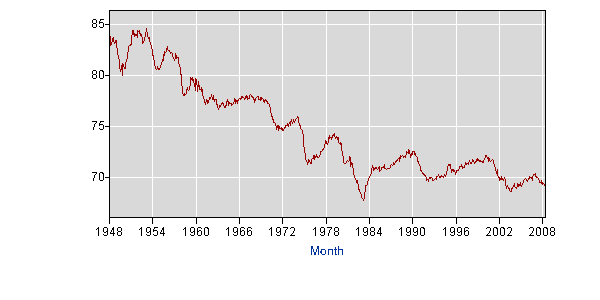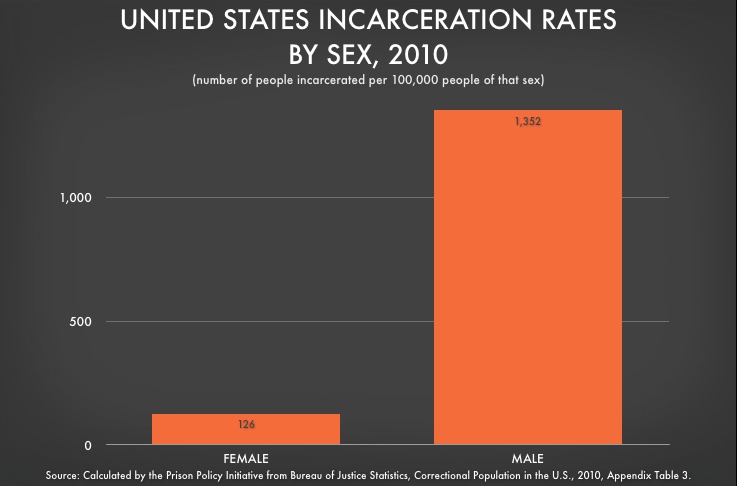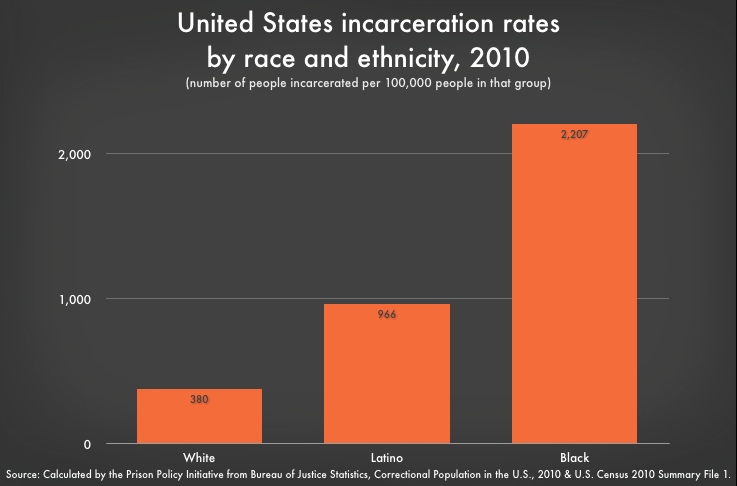Men's Group
Related: About this forumThe FAQ
Last edited Fri Jan 13, 2012, 04:59 PM - Edit history (1)
I meant to do this as my 20,000th post, but I was dilatory.
When someone lists problems men face, they are immediately challenged on the facts because conventional wisdom holds that they can't possibly be true.
For navigation, I'm going to format this list as an OP, replies based on topic, and pin it to the top. I hope that this can serve as a maintained permanent resource.
Of course, feel free to add or discuss.
lumberjack_jeff
(33,224 posts)Last edited Sat Jun 9, 2012, 04:18 PM - Edit history (5)
[font color="blue" size=4 face=courier]Employment[/font]
Here's the unemployment to population ratio among men

[font color="blue" size=4 face=courier]Unemployment[/font]
As of December 2011, 910,000 more men than women are unemployed, even after recovering from "the mancession".
http://www.bls.gov/news.release/empsit.t02.htm
http://www.economist.com/node/18618613
This collapse of work partly reflects the recession of 2008-09, which drove America’s unemployment rate into double digits. It is still high—9.3% for men—and almost half of the jobless have been out of work for more than six months. But there is another cause, less noticed and of longer standing. To count as unemployed, you have to be looking for work, yet ever more men have simply dropped out of the recorded labour force. Some, it is true, work “off the books”; but many receive disability insurance, are in prison, live on spouses’ or partners’ incomes, or have otherwise given up looking for a job. America has a smaller share of prime-age men in the workforce (ie, in a job or seeking one) than any other G7 economy (see chart 1).
The decline of the working American man has been most marked among the less educated and blacks. If you adjust official data to include men in prison or the armed forces (who are left out of the raw numbers), around 35% of 25- to 54-year-old men with no high-school diploma have no job, up from around 10% in the 1960s. Of those who finished high school but did not go to college, the fraction without work has climbed from below 5% in the 1960s to almost 25% (see chart 2). Among blacks, more than 30% overall and almost 70% of high-school dropouts have no job.
<snip>
A second explanation is that American men have let their schooling slide. Those aged between 25 and 34 are less likely to have a degree than 45- to 54-year-olds. As David Autor of MIT points out, they are also less likely to have completed college than their contemporaries in Britain, Denmark, France, Ireland, the Netherlands and Spain. In recent years America’s university graduation rates have slipped from near the top of the world league to the middle. Men are far likelier than women to drop out. Their record at school is bad too. This educational decline has a racial edge. Black and Hispanic boys are far less likely to graduate from high school than white or Asian youths. A smaller fraction starts college and a larger fraction drops out.
[font color="blue" size=4 face=courier]The wage gap[/font]
In 2007 (before the mancession) the American Association of University Women reported...
http://www.aauw.org/learn/research/upload/behindPayGap.pdf
receive the same pay? The answer is no. The evidence shows that even when the “explanations” for the pay gap are included in a regression, they cannot fully explain the pay disparity. The regressions for earnings one year after college indicate that when all variables are included, about one quarter of the pay gap is attributable to gender. That is, after controlling for all the factors known to affect earnings, college-educated women earn about 5 percent less than college-educated men earn. Thus, while discrimination cannot be measured directly, it is reasonable to assume that this pay gap is the product of gender discrimination
If a man and a woman work the same hours, in the same job, with the same experience, the 2007 pay gap was 5%. One of the factors that they overlooked to explain the remaining 5% is the fact that women tend to not negotiate for salary. Bear in mind, this study was created before men's unemployment shot up from about 8% to about 11%.
[font color="blue" size=4 face=courier]Wages[/font]

This generation of men will earn 28% less than their grandfathers.
http://economix.blogs.nytimes.com/2011/03/04/the-struggles-of-men/
caseymoz
(5,763 posts)Only 12 Fortune 500 companies have female CEOs (2.4%). There are 97 women in Congress (18.1%) and only 24.2 percent of state legislatures are women.
(Those figures were uncovered through a routine Google search and are easy to verify.)
In finance, women are 2.5% of the chief executives (similar to Fortune 500 companies) and 16.8% of the number of executive officers.
http://www.20-first.com/1411-0-the-situation-of-women-in-the-finance-industry-of-the-us.html
Also, (same source) women are leaving the finance industry at a rate of 141,000 over a decade, while the number of men increased 389,000. This has driven the percentage of males in the industry up by 9.1 percent.
I'm not arguing with your numbers. I'm just saying that women are under-represented among people who are the real decision-makers in the country.
This also suggests what we already know, that the 1% hold themselves by different rules than what they impose on the rest of us.
shaayecanaan
(6,068 posts)I'm not really that concerned with making sure female ceos get their extra million dollars a year as I am for making sure that the working class gets a living wage.
lumberjack_jeff
(33,224 posts)Last edited Sat Jan 14, 2012, 11:58 AM - Edit history (1)
[font color="blue" size=4 face=courier]Life expectancy[/font]
Men die at an earlier age, but that wasn't always the case
Men live roughly 10% shorter lives
http://www.cdc.gov/nchs/data/nvsr/nvsr59/nvsr59_09.pdf see page 2
A black male born in the US is unlikely to live long enough to collect social security.
[font color="blue" size=4 face=courier]Premature deaths[/font]
More men die of every preventable cause, including traffic accidents, suicide, violence and workplace injury.
http://www.worldlifeexpectancy.com/usa-cause-of-death-by-age-and-gender
[font color="blue" size=4 face=courier]Healthcare spending[/font]
Due to their longer lives, the lifetime healthcare expenditure for the average woman is 34% higher.
Per capita lifetime expenditure is $316,600, a third higher for females ($361,200) than males ($268,700). Two-fifths of this difference owes to women's longer life expectancy. Nearly one-third of lifetime expenditures is incurred during middle age, and nearly half during the senior years. For survivors to age 85, more than one-third of their lifetime expenditures will accrue in their remaining years.
Gender is, by a huge margin, the biggest determinant of health care cost, far bigger than diet or smoking.
http://www.ncbi.nlm.nih.gov/pmc/articles/PMC1361028/
Prior to health care reform, these higher costs were reflected in higher individual insurance rates. HCR prohibits gender as a rating critera, so men's premiums go up and women's go down. In effect, men subsidize the higher cost of women's longer lives.
http://www.nytimes.com/2010/03/30/health/30women.html
(I love this headline: "HCR cuts the cost of being a woman". Since "the cost of being a woman" is primarily due to living a long time, I'd happily pay.)
Response to lumberjack_jeff (Original post)
Post removed
lumberjack_jeff
(33,224 posts)Last edited Fri May 18, 2012, 09:47 AM - Edit history (5)
[font color="blue" size=4 face=courier]Disproportionate treatment[/font]
[Men get harsher sentences for the same crime.
The incarceration rate of men is 11x higher than women.

By way of comparison, here is the incarceration rates by race. Race is comparatively trivial as a determinant of going to jail compared to gender. Blacks are imprisoned at 6x the rate of whites. Statistically, a black man who is in jail is mostly there because he's a man.

[font color="blue" size=4 face=courier]Bias in family court[/font]
http://www.glennsacks.com/fathers_bear_the.htm
An Ohio study published in Family Advocate found that fathers seeking sole custody obtain it in less than 10% of cases, and a Utah study conducted over 23 years found similar results. According to the 2000 Census Bureau report, mothers comprise 85% of all custodial parents.
lumberjack_jeff
(33,224 posts)Last edited Sat Jan 14, 2012, 01:00 PM - Edit history (2)
Institutional discrimination is the kind of hard discrimination which is backed up not just by cultural norms, but by force of law. A supreme irony is that if the equal rights amendment were passed today, these are the laws which will be rendered unconstitutional.
http://www2.ed.gov/pubs/genderequity/gender_equity.pdf
Here's a good one. The US department of education gives grants and scholarships to promote "equity" in education... by increasing the 50% margin by which women are more likely to graduate from college. You can't apply for these grants if you're a man.
http://murray.senate.gov/public/index.cfm/newsreleases?ContentRecord_id=a3851ddf-8821-48fd-b78d-c4f0330e09cd
Homeless women veterans act. I would think that the homelessness of any veteran regardless of gender would be of equal concern.
http://www.seattlepi.com/national/article/Selective-Service-eyes-women-s-draft-1143723.php
Only men are required to register for the draft.
Men pay most of social security taxes, yet represent only about 40% of recipients.
http://www.ssa.gov/women/
lumberjack_jeff
(33,224 posts)[font color="blue" size=4 face=courier]Teacher demographics[/font]
http://www.ncei.com/POT05PRESSREL3.htm
[font color="blue" size=4 face=courier]Children's attitudes[/font]
http://www.guardian.co.uk/education/2010/sep/01/girls-boys-schools-gender-gap
Boys come round to this view by the age of seven or eight and assume that girls will outperform them at school and behave better in lessons, research from the University of Kent shows.
<snip>
Girls' performance at school may be boosted by what they perceive to be their teachers' belief that they will achieve higher results and be more conscientious than boys, the academics claim. Boys may underachieve because they pick up on teachers' assumptions that they will obtain lower results than girls and have less drive.
The findings come just over a week after exam results revealed that the gap between boys and girls at GCSE is widening. This summer, the pass rate for girls was 72.6% at A* to C, compared with 65.4% for boys. Last year, the rate was 70.5% for girls and 63.6% for boys.
[font color="blue" size=4 face=courier]Outcomes[/font]
http://www.nypost.com/p/news/opinion/opedcolumnists/the_nation_schools_are_failing_boys_nvjstdJ0OEupWcNtrm1wUN
http://www.insidehighered.com/news/2008/05/21/gender
Thomas Mortenson, a senior scholar at the Pell Institute for the Study of Opportunity in Higher Education, didn't question the specific numbers in the report or the idea that both male and female students can succeed at the same time. "Women have made huge progress in education over the last six decades," he said. "The success of women is a great story -- it shows what we can do when we set our minds to task."
But he said that in 1970, when he started his career in higher education policy analysis, there were 1.5 million more men than women in higher education and "I recall vividly that women complained that this was a crisis. Now there are 2.7 million more women than men in higher education and the feminists assert that this is not a crisis. What am I missing here?"
He noted the hugely disproportionate rates of suicide among men who are 25 to 34, and of incarceration, and asked how this could be anything but a crisis.
[font color="blue" size=4 face=courier]Grades and test scores[/font]
Boys test as well as girls on standardized tests, yet get poor grades. Clearly, grades are awarded on other factors than mastery of the subject matter.
http://www.cbsnews.com/stories/2002/10/31/60minutes/main527678.shtml
http://heraldnet.com/article/20100530/NEWS01/705309875
Through last June, just under half of the county's girls — 48.8 percent — had a grade point in the solid A to B range of 3.0 or above. A third of boys — 33.4 percent — could make the same claim.
At the same time, nearly a third of boys had a grade point average of 1.99 or less, the C-minus to F range, compared to fewer than 1 in 5 girls.
The data also shows that high school girls tend to earn higher grades in all core subjects, including math, at all grade levels despite the fact that boys scored slightly higher in that discipline on last year's state WASL exams.
[font color="blue" size=4 face=courier]Possible interventions[/font]
http://www.singlesexschools.org/evidence.html
Percentage of students scoring proficient on the FCAT
boys in coed classes: 37% scored proficient
girls in coed classes: 59% scored proficient
girls in single-sex classes: 75% scored proficient
boys in single-sex classes: 86% scored proficient.
Remember, these students were all learning the same curriculum in the same school. And, this school "mainstreams" students who are learning-disabled, or who have ADHD etc. Many of those boys who scored proficient in the all-boys classes had previously been labeled "ADHD" or "ESE" in coed classes.
lumberjack_jeff
(33,224 posts)Men are a minority of the population, roughly 49%.
Men are a minority of voters, about 46% of registered voters are men.
[font color="blue" face=courier size=4]Wealth[/font]
http://www.pbs.org/ttc/headlines_economics_philanthropy.html
lumberjack_jeff
(33,224 posts)91% of New Homes
66% PCs
92% Vacations
80% Healthcare
65% New Cars
89% Bank Accounts
93% Food
93 % OTC Pharmaceuticals
American women spend about $5 trillion annually…Over half of the U.S. GDP**
*Marketing to Women Conference
shawn703
(2,712 posts)91% of new homes seems high, unless a big chunk of that is from married couples who joint sign on a house.
lumberjack_jeff
(33,224 posts)The methodology obviously asks couples "which of you selected this vacation/house/car". If that weren't the case, the percentages would be the same for each spending category. (e.g. we both chose these curtains equally)
Warren DeMontague
(80,708 posts)Especially since they come from the "Marketing to women blog" and the only sourcing on them is the "Marketing to women conference".
I have a hard time believing, for instance, that women buy 93% of the food in this country. That just doesn't seem feasable.
lumberjack_jeff
(33,224 posts)Last edited Tue May 22, 2012, 09:35 AM - Edit history (2)
The stats were considered valid enough to justify/defend/reinforce a commercial boycott on Limbaugh because of his comments about Sandra Fluke.
I can't find any sources which indicate that men make most of the buying and investing decisions.
This raises an interesting question. Is the power of money the ability to earn it or the ability to spend it?
craichead65
(12 posts)They'll quickly confirm that it's a foregone conclusion among marketing companies that women make or influence over 80% of consumer purchases.
Incidentally, the first reference to this I've ever seen was in a book published in 1942, so it's been that way for quite a while.
Warren DeMontague
(80,708 posts)So theres that.